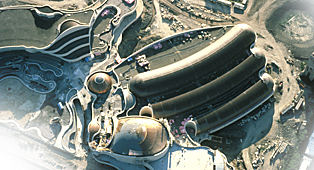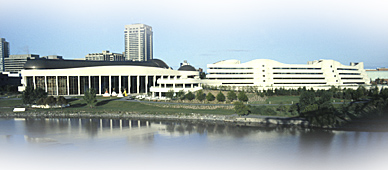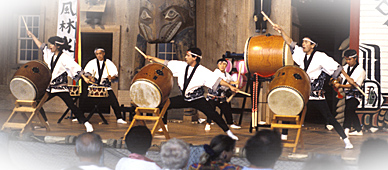FULL TOUR
Conceiving a National
Museum - THE MUSEUM AS SYMBOL
Between 1983 and 1989 a sculpture
of monumental proportions gradually took shape on the northern
bank of the Ottawa River opposite Parliament Hill, on a site
known as Parc Laurier. This was the Canadian Museum of
Civilization (CMC).

The CMC opened to the public on 29 June
1989. Its natural forms echo Canada's geological past, when
wind, water and ice shaped the Canadian landscape.
© Canadian Museum of Civilization, S2004-1238, CD2004-1376
|
The rising building's striking design evoked the eroded
landforms and streambeds of post-glacial Canada. Being on one of
the most conspicuous sites in the National Capital, it began to
attract the public's notice.
The museum was soon added to the world "visit list" of
important cultural projects; foreign delegations came to see it
from such countries as the United States, Britain, Japan, South
Africa, the Soviet Union, China and Australia. Its daringly
innovative design and its symbolism led to frequent comparisons
with the Canadian Pavilion at Expo '86 or with the Sydney Opera
House.
Such comparisons barely glimpse what the new Canadian Museum
of Civilization represents for Canada. Along with the many other
museums in this country, it has an indispensable part to play in
assuring the vitality of Canadian culture, for an understanding
of the past is the foundation for the future.
Canada being a nation of immigrants from diverse backgrounds,
there is a national tendency to look to public institutions to
preserve and interpret our past experiences. Museums therefore
have a unifying role. Museums are sometimes described as oases
of the past in a rapidly changing world, a place to seek one's
roots. They do not resist change, however, but show the
contrasts and continuities between past and present, and thus
portray change as a natural, explicable, and acceptable fact of
life.

CMC's daringly innovative architecture
makes it a major national symbol.
© Canadian Museum of Civilization, D2004-18585, CD2004-1377
|
If museums generally are symbols of our society and its
cultures, and as central to social development as the heritage
which they help preserve and explain, what of the National
Museums in particular? The National Capital is itself a symbol
of national identity. Next to such historic landmarks as the
Parliament Buildings, cultural institutions are the major
contributors to that image, and to the region's selection as a
tourist destination. A national museum of human history is part
of that symbolization. It helps define cultural identity and the
country itself. It stimulates pride amongst Canadians in their
own culture. It announces to the world that Canada is a nation
with special and unique characteristics. It reflects the ways in
which various peoples, bringing their own cultures, have met the
challenges of the land, by shaping it and by shaping themselves
to it.
CMC offers, both to Canadians and non-Canadians, an initiation
into the national identity. It submits itself to the confines of
scholarly objectivity and seeks to make itself of utmost
relevance to present issues and concerns. In a sense, a national
museum elevates culture by recognizing it and placing it in a
context that can be likened to a temple or a treasure-house. As
a temple of culture CMC is very much a ritual space. This fact
has been a key to the types of experiences it has sought to
programme into its new facilities.

Because Canada is a multicultural
society, the CMC feels that it has a mandate to look at the
civilizations of origin of Canadian immigrants.
© Canadian Museum of Civilization, D2004-18586, CD2004-1377
|
CMC is also a symbol of the federal government's commitment to a
role in cultural affairs. The creation of a new national museum
of human history is only one element in the development of a
cultural pilgrimage centre: the "museum capital of Canada"
as it has been tagged. The construction of new buildings for CMC
and for the National Gallery of Canada, the creation of the
National Aviation Museum and the Museum of Contemporary
Photography, and rehousing of the National Postal Museum and the
National Archives of Canada, were all components of this
cultural master-plan.


|